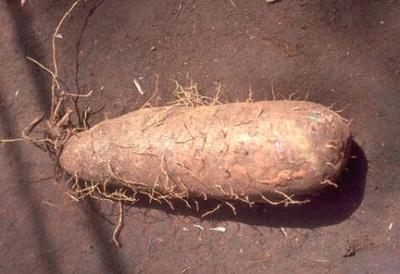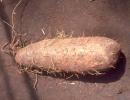
|
Yam
Scientific name:
Dioscorea alata
Order/Family:
Violales: Dioscoreaceae
Common names:
White yam, Water yam, Greater yam
Pests and Diseases:
Anthracnose
Fusarium wilt
Greater yam beetle
Mealybugs
Pigs
Scale insects
Rodents, Snails, Larger grain borer, Scales, Mealybugs, Nematodes, Termites
|
Anthracnose (Glomerella cingulata)
It is a serious disease which results in blackening and dieback of the leaves. The disease is more severe on white yam than in other edible yams.
- The best control measure is the use of resistant cultivars such as 'TDA 291' or 'TDA 297' (International Institute for Tropical Agriculture (IITA).
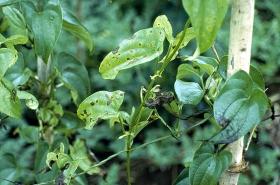
© Courtesy EcoPort (http://www.ecoport.org): Grahame Jackson
Fusarium wilt (Fusarium spp.)
Fusarium wilt and other tuber rots afflict white yam tubers, especially in storage.
- Avoid injuries to the tubers.
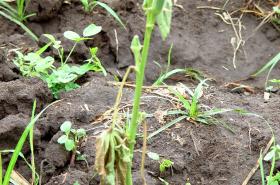
© A.M. Varela & A.A.Seif, icipe
The greater yam beetle (Heteroligus meles)
Heteroligus meles is widespread in tropical Africa. It attacks the tubers. Adult beetles eat the planting setts and plants may wilt and die. The holes in tubers reduce market value.
Adult beetles are 23-33 mm long, dark brown to black, with 2 prominent knobs on
the head. The beetles lay eggs in the soil close to river banks and these hatch to produce
creamy-white to grey larvae, which feed on grass roots and other organic matter. From
egg to adult takes 22-24 weeks and emergence coincides with the beginning of the
rains and the planting of yams. Further attack occurs just before harvest when the
beetles again feed voraciously and then migrate to the breeding sites.
- Yam beetles can be controlled by planting as late as possible in the season.
Yam scale (Aspidiella hartii)
Infestations of tubers and sometimes foliage cause poor growth. Stored tubers are
particularly susceptible to attack and large numbers cause shrivelling.
Adult female scales are pinkish-brown, roughly oyster-shaped, conical, with a white
patch at the tip of the cone. Younger scales are relatively more white. Crawlers are
yellow.
| General Information and Agronomic Aspects | Information on Pests | |||
| Information on Diseases | Information Source Links |
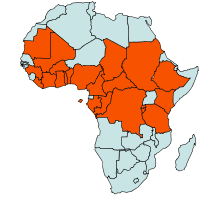 |
| Geographical Distribution of Yam in Africa |
West Africa is the most important area for yam production in the world. Over 90% of global yam production comes from this region. Nigeria alone produces about 68% of the world's yams, followed by Cote d'Ivoire, Benin, Ghana and Togo. Within West Africa, production occurs in the northern forest and southern savanna zones. Further north, the rainy season is too short, and further south the soils are waterlogged and there is too much cloud cover for economical yam production.
Elsewhere in Africa and in the rest of the tropics, the white yam (water yam) is the dominant yam species. Significant quantities are produced in Democratic Republic of Congo, Ethiopia, the Central African Republic and Sudan.
Yam is a preferred food security crop in the drier areas of Kenya. One plant is reported to be able to produce 1 full 90 kg bag of tubers, which can be harvested a few at the time for home consumption or sold in the market for a good price. Many families in Kenya plant yam near the trees in the shamba (farm), so they can get support for climbing vines.
The tubers and larger bulbils of white yam are consumed as a starchy staple, after cooking in various ways. They can be processed into yam flakes or yam flour. Their use as a source of starch is minor.
Nutritive Value per 100 g of edible Portion
| Raw or Cooked Yam | Food Energy (Calories / %Daily Value*) |
Carbohydrates (g / %DV) |
Fat (g / %DV) |
Protein (g / %DV) |
Calcium (g / %DV) |
Phosphorus (mg / %DV) |
Iron (mg / %DV) |
Potassium (mg / %DV) |
Vitamin A (I.U) |
Vitamin C (I.U) |
Vitamin B 6 (I.U) |
Vitamin B 12 (I.U) |
Thiamine (mg / %DV) |
Riboflavin (mg / %DV) |
Ash (g / %DV) |
| Yam cooked | 116 / 6% | 27.5 / 9% | 0.1 / 0% | 1.5 / 3% | 14.0 / 1% | 49.0 / 5% | 0.5 / 3% | 670 / 19% | 122 IU / 2% | 12.1 / 20% | 0.2 / 11% | 0.0 / 0% | 0.1 / 6% | 0.0 / 2% | 0.8 |
| Yam raw | 118 / 6% | 27.9 / 9% | 0.2 / 0% | 1.5 / 3% | 17.0 / 2% | 55.0 / 6% | 0.5 / 3% | 816 / 23% | 138 IU / 3% | 17.1 / 28% | 0.3 / 15% | 0.0 / 0% | 0.1 / 7% | 0.0 / 2% | 0.8 |
Since it requires 7-10 months to mature in the field, it is essential that the rainy season lasts at least as long, unless supplementary irrigation can be provided. A well-distributed rainfall (or water supply) of 1500 mm per annum is adequate for yam production. However, dry spells of up to 1 month during the growing season do not severely reduce yields. It is occasionally grown in high rainfall areas in East Africa. Reported annual rainfall range for growth is 700-8000 mm with the optimum between 1200-4000 mm.
It is mostly a crop of the lowlands, though it occurs at elevations of up to 2500 m (in India). It tolerates poorer soils than most other cultivated yams. White yam is sensitive to aluminium toxicity in the soil.
It thrives in deep, fertile, well drained, loose, loams and sandy-loam soils with low levels of salinity. It responds well to manuring. However, compared with other tropical tuber crops, yams require soil of high fertility. Heavy clays tend to be waterlogged and result in tuber rots and difficult harvesting. Gravel or rocky soils tend to hinder tuber penetration. Reported soil pH range for growth is 4.8-8.5 with the optimum between 5.5-6.5.
Nematodes attack the plant, resulting in warty appearance of the tuber.
Wild animals such as pigs and rodents may destroy the crop in some locations.
- A.A. Brunt, G.V.H. Jackson and E.A. Frison, FAO/IBPGR Technical guidelines for the safe movement of yam germplasm. www.cabicompendium.org
- CAB International (2005). Crop Protection Compendium, 2005 edition. Wallingford, UK www.cabi.org
- Nutrition Data www.nutritiondata.com.
- OISAT: Organisation for Non-Chemical Pest Management in the Tropics. www.oisat.org

 Back
Back
